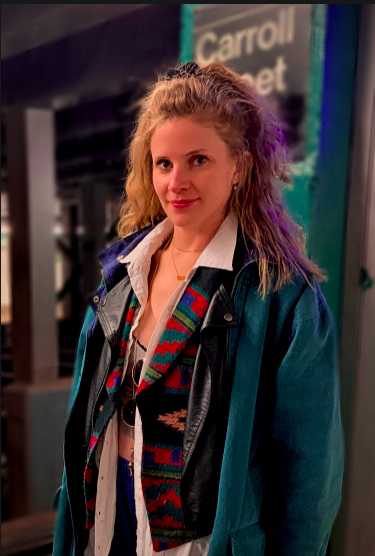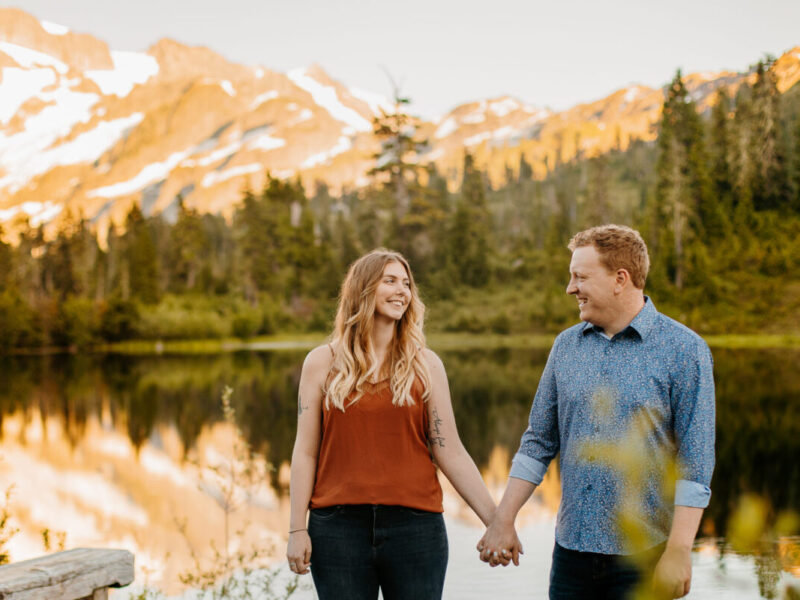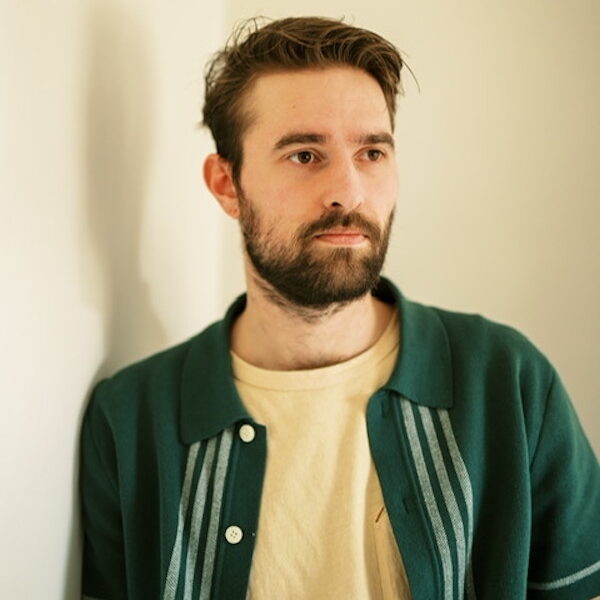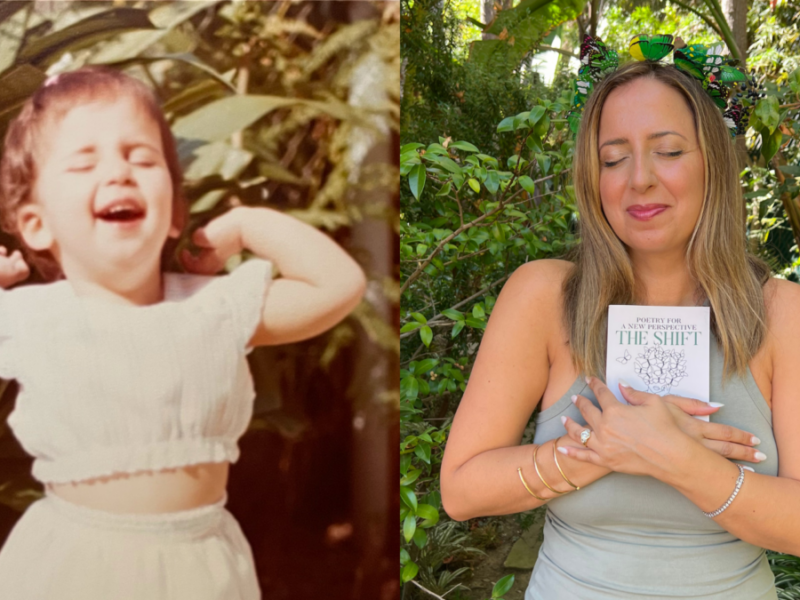Examining Love in the Rear-View: An Interview with Emily E. Dalton
Spurred by a dare, a kiss between two college friends sets in motion a story that is equal parts romance and coming-of-age. Gender, sexuality, and societal expectations fall under the microscope as Be Straight With Me (available May 19) splices formative memories into this retrospective on a whirlwind romance.
Young Emily, caught between tomboy and girly-girl, meets Max (intimately referred to as “you” throughout the book), who is boisterous, well-liked, and recently openly gay. Their friendship takes a surprising turn as the two fall in love, experiment with drugs; travel abroad; try sleeping with other people (together), and everything in between.
Author Emily Dalton harnesses a frank yet tender spirit throughout this memoir-in-verse—one unique yet universal enough to harken readers back to their own salad days. Dalton grew up in rural northern Connecticut and studied writing at Middlebury College in Vermont. At the age of 25, after three years of living in New York City, she quit her job, moved home, and turned her focus back to writing. While working part-time as a blacksmith’s apprentice, she slowly transformed her senior thesis into the first draft of Be Straight with Me. With her first release on the horizon, Dalton was kind enough to sit down with Read Poetry to unpack her experience.
Thea Voutiritsas: What are you currently reading?
Emily Dalton: I’ve always wished that I was better at reading—and actually finishing—novel-length books, but alas, that skill is still a work-in-progress. The three books I have open right now are Envelope Poems by Emily Dickinson, Pobby and Dingan by Ben Rice, and Mary Ventura and the Ninth Kingdom by Sylvia Plath. Aside from those, I’ve been reading a lot about the archaeological history of my hometown, Simsbury, CT.
TV: Who are a few of your favorite writers and how did you discover them?
ED: Mary Oliver, Emily Dickinson, Charles Simic, and Lewis Carroll. Technically, I’ve known the names of these writers since high school. Truthfully, I did not appreciate them until years later. My senior thesis advisor, Jay Parini, was the one who suggested that I start to read more poetry from writers like Mary Oliver and Charles Simic during a time in which I was telling a lot in my writing, but not really showing. They are both masters of that art. As for Emily Dickinson, it was a few years ago, when I was living at home and decided to visit her home (now a museum) in Amherst, MA. Lewis Carroll is a bit of a wildcard in this mix; I was browsing through a bookstore during my first few years in NYC and came upon a beautiful 150th-anniversary edition of Alice’s Adventures in Wonderland.
TV: Be Straight with Me began as your senior thesis. What inspired you to revisit the work?
ED: The feeling of hitting an emotional rock bottom is obviously quite sad, but it also has the potential to jumpstart new feelings. I was lucky enough to feel an unexpected sense of empowerment when I hit the bottom of my depression around the age of 24 or 25. Don’t get me wrong, I certainly sat on the ground and cried for longer than I’d like to admit . . . But after I did that for long enough, I got so bored that my mind actually started to trick itself into being interested in something other than my latest or next romantic relationship. And it did this in a very skillful way.
I thought I was still just obsessing over my ex when I googled ancient Greek mythology, or the different types of eros, or how Plato wrote down everything that Socrates taught him. (And I absolutely was doing that.) But, unbeknownst to me, I was also poking at the surface of a question much bigger than “why didn’t it work out with him?”—and much more important, too. For me, feeling so empty slowly evolved into a feeling of having nothing left to lose. This fearlessness is what inspired me to face down my past and find new meaning in the story that defined it.
TV: What changes did the work undergo in its transformation from thesis to published verse?
ED: To answer this question in full, I have to briefly explain that I had never written poetry until my senior year at Middlebury, when Jay Parini suggested that I write my senior thesis about my ongoing relationship—and that I write it in verse. I had no idea what I was doing back then, but thankfully I had a natural sense of rhythm and a story that was emotionally complex enough to make for a noteworthy (but quite abstract and rambling) narrative told through poetry. To my shock, the thesis resonated with my professors and won an award at graduation.
Fast forward three years, and I finally set back to work on it. But my vision for the book was to transform it from poetry to prose. I spent a year or so writing out every moment, every memory, every tangential thought and detail from the five-year relationship, and then I sat on 600 pages of prose for a few months. It was during these months that I left NYC and moved back home to live with my parents in CT. Another six months of revisions resulted in the ~300 pages of prose that I actually pitched out to agents.
And then, it was about halfway through the editorial stage with my agent that he made the bold and terrifying suggestion that I turn the prose BACK into poetry. I was very unfamiliar with the concept of a “novel in verse” and it took some convincing, but eventually it became clear to me and all of my beta readers that turning my prose memoir into a memoir in verse was the equivalent of mining out the gold from the gravel.
TV: How did leaving NYC help you write (or finish) your first book?
ED: It’s a cliche, but it’s a cliche for good reason. Returning home to the place where I initially lost my sense of self was pivotal in finding it again. Be Straight With Me is very much a psychological manifesto and digging that deep into my psyche was only possible for me when I removed the distractions of working, dating, partying, and living in a big, bustling city amidst many of my college and high school friends. When I left and went home, I also essentially disappeared from social media. Focusing on what I really wanted to understand and accomplish in life was a lot easier when I wasn’t constantly comparing myself to my peers.
TV: Has publishing your first book changed your process for writing? If so, how?
ED: Trying to write something worthwhile takes major guts no matter what, but trying to get that something actually picked up and published takes a different kind of bravery. I had to find and hold on to the courage to believe in myself, and that alone was a struggle. But to get my story published took an even more elusive sense of courage: the courage to take others’ opinions into consideration and to question and examine my motivations for writing.
In my experience, publishing my first book was as rewarding as it was humbling. It was hard enough to cut my initial 600 pages of prose in half, and that much harder to ultimately turn 300 pages of prose into 250 pages of poetry. As my agent and my editor know, I still recoil in angsty avoidance for a day or two whenever a new round of edits comes in. My first instinctual reaction to negative feedback used to be defensive and self-righteous. Now I am trying to embrace the process of stepping outside of my own tunnel vision and working with the oppositional ideas to make my original ideas stronger.
TV: You note that memories, much like reflections, appear differently depending on who is looking. Do you think memories also change over time? If so, how has your perspective on your own memories changed?
ED: Absolutely. The mirror metaphor most certainly applies to ‘when’ and ‘where’ as accurately as it does to ‘who’ in my opinion. In the first rounds of drafting this story, I was still clinging very tightly to preserving the tragic, star-crossed love story: he was Romeo and I was Juliet. Over time, that wistful nostalgia morphed into resentful vengeance: he was the bad guy and I was the good guy. In the end—and how I hope the final draft comes across—I was able to reflect on the relationship and realize that we were just two young people who felt a little less lost when we were together. You might equate it to a slightly disordered Kübler-Ross model of the stages of grief: at first, the memories made me feel sad; then they made me feel angry; and in the end, thankfully, more enlightened.
TV: You made an interesting choice to insert reflections throughout the retelling of Max and Emily’s story. How do you think these early moments informed the two’s interactions down the road? How did you decide where to place each reflection?
ED: When I used to try to explain my relationship with Max to other people (both during the relationship and afterward), it almost always felt like I was trying to recount a very weird and vivid dream to someone else. If only they could have the same memories and visions and understanding in the moment as I did, then I wouldn’t sound so delusional!
It wasn’t until a person actually met Max, or witnessed Max and me interacting, that they’d experience that “a-ha” moment and begin to understand how deeply we were connected. Most often, this happened with those in my life who knew me the best: my immediate family and my best friends outside of college. Knowing that I always straddled stereotypes and craved romantic challenges made it much easier to piece together how I fell in love with someone like Max. I wanted to give readers—people who had never met either of us—that same advantage over the suspension of disbelief.
TV: In many ways, Be Straight with Me is as much a love story as it is a story of self-discovery. There is one line in particular that struck me in the book: “Winning praise from you gives me a reason to start liking myself again.” How does the way Emily manages external and internal validation sources change?
ED: Max was the first person I’d ever known to openly and unapologetically acknowledge the innate contradiction of the human experience: we all want to be seen as part of a bigger picture, but we also crave the opportunity to be seen alone. How can someone honor two opposing ends of a spectrum, yet still present their identity honestly, and in the same way, to everyone they meet?
I was in awe of Max’s ability to make that chaos feel more universal, and when we became close, I started to learn how to acknowledge my own inner contradictions. I was fairly shy and introverted, but I felt bitter when I wasn’t getting enough attention from others. In a way, Max gave me the starter-kit of resolving those differences—he paid attention to me, which eventually made me pay more attention to myself. I think that was what really prompted me to examine my own reflection and find peace with the person staring back.
TV: The relationships throughout the book give us a chance to explore gender norms and societal expectations. Where do you think the line is between being yourself and performing a role?
ED: I think the line is as smudged and blurry as the line between nature and nurture. That said, I am an adamant believer in the value of solitude, and in my opinion, the best place to find solitude is outside in nature. Anytime we are interacting with one another, we are, to an extent, performing a role. So I think that performing a role in society is important, but I also think that being happy with that role is equally as important. I did not feel genuinely happy about performing the role of a young female until I felt completely content walking through the woods alone.
TV: Throughout the book, you grapple with the idea of being “feminine enough.” How do your relationships in the book complicate or elaborate on this struggle?
ED: Thankfully, my relationships in Be Straight With Me—with high school boyfriends, with my family, with my female friends, with Max, and with myself—greatly complicated my struggle to be feminine enough! So much so that they forced me into reevaluating how much femininity is “enough” for me—and only me. The struggle to be more feminine evolved into the struggle to be more open and accepting of different definitions and demonstrations of femininity and masculinity. I recently stumbled upon a Susan Sontag quote that sums up my current viewpoint on gender roles:
“What is most beautiful in virile men is something feminine; what is most beautiful in feminine women is something masculine.”
TV: You seem to take a particular interest in shoes, from @somebody_elses_shoes to noting your own beloved converse and admiring shoes hanging from a line abroad. What makes shoes, in particular, a special subject to you?
ED: Shoes, much like articles of clothing in general, are a good way to express oneself, but on a deeper level, they symbolize how we protect our vulnerabilities. We are the only animals capable of so harshly and consciously persecuting one another for deviating from what seems ‘normal’ or ‘inside the average’. But we are also highly aware of the fact that genetic diversity is a key to survival and fitness and evolution. I think shoes continuously appear in my work because they represent a lot of tough questions for me…
Why are we the only animals who have developed the need for artificial protection on our bodies? Why did we become so naked and hairless and exposed to the elements? Why did our soles become soft and vulnerable? What do we use to protect these vulnerabilities? How do we travel through our daily lives, protected by the shells we’ve artificially constructed?
TV: What’s the biggest mistake you’ve made as a writer?
ED: Well, to quote a fortune cookie that my niece cracked open the other night, “there is nothing final about a mistake, except its being taken as final.” But I would say that when I first started to refocus on writing after college, I made the mistake of assuming that writing for myself and writing for others could easily and quickly be one-in-the-same. I was very impatient and hastily sent my poems and essays to other people before I even knew what I was really hoping to communicate. It’s very tricky to tell a good story to someone else before you’ve taken the necessary time to tell it to yourself!
TV: What does literary success look like to you?
ED: On a logistical level, I suppose it looks like the ability to earn enough income through writing that I can support myself and thus continue through life with a career as a writer. On an emotional level, I think it looks like achieving the balanced outcome between writing for oneself and writing for others: the author learns something valuable about the human condition and is then capable and imaginative and lucky enough to share and teach it to others.




